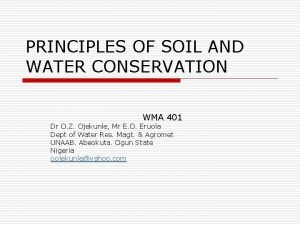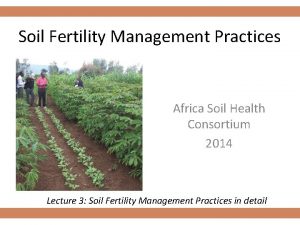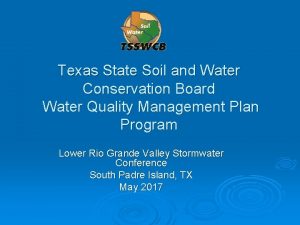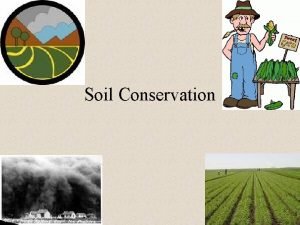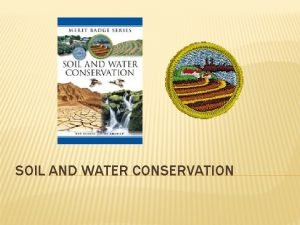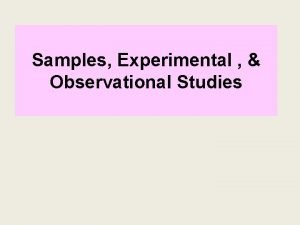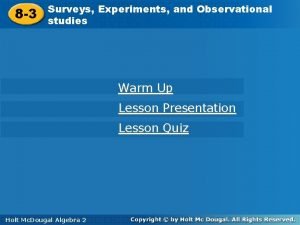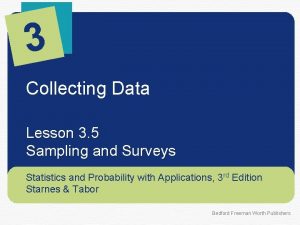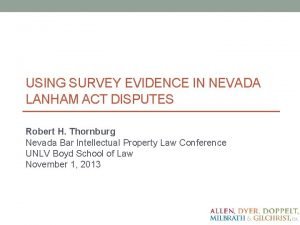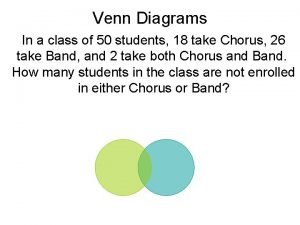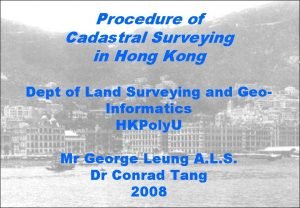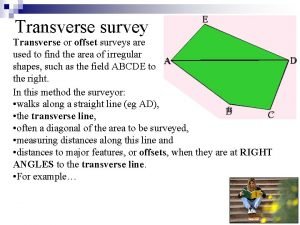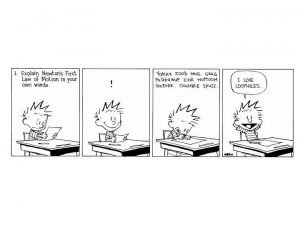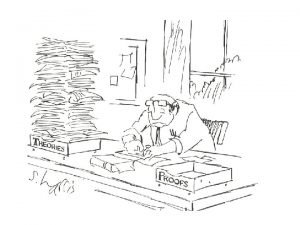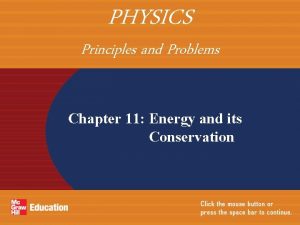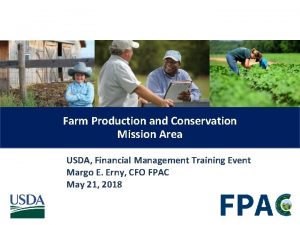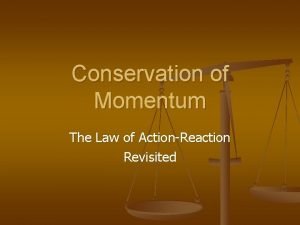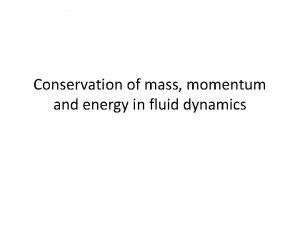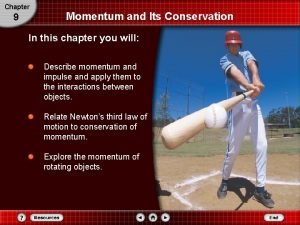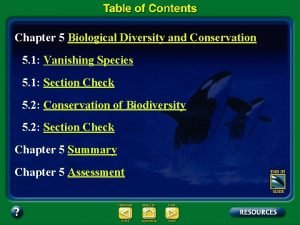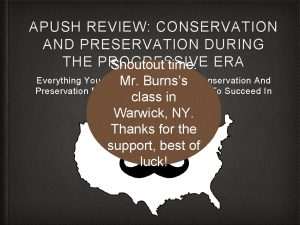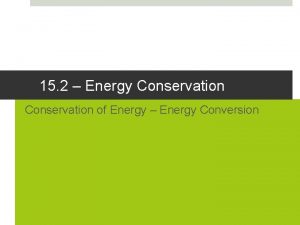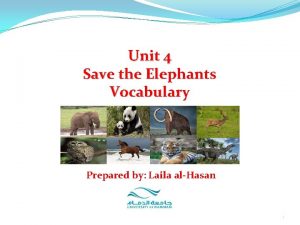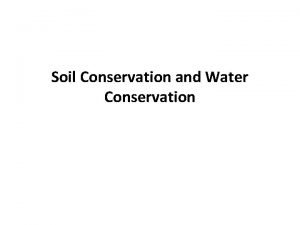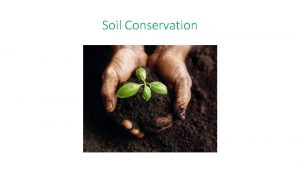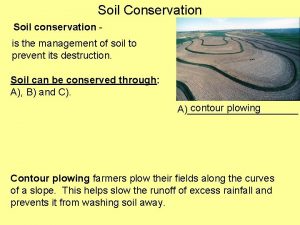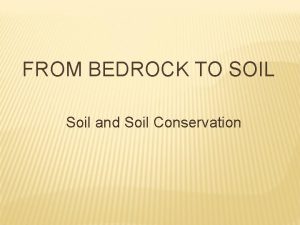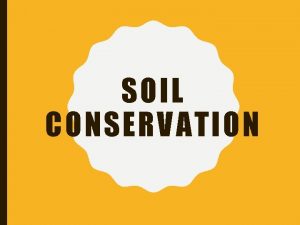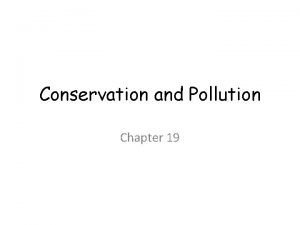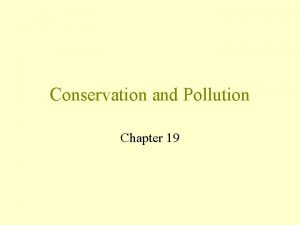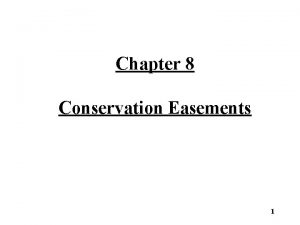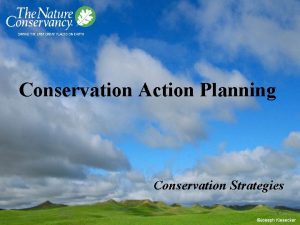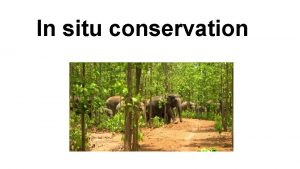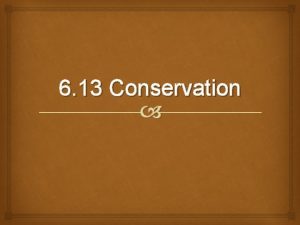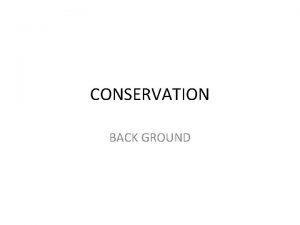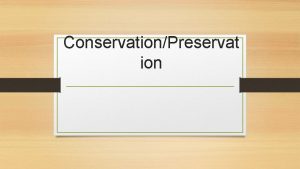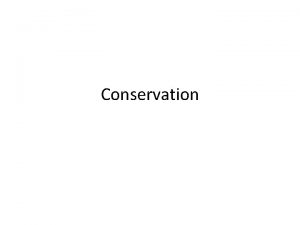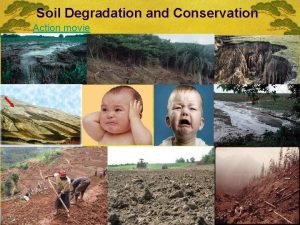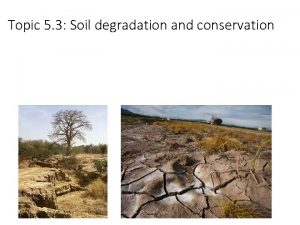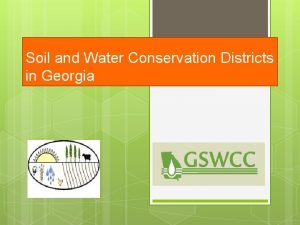Lecture 24 Soil Surveys and Conservation Soil Surveys





















































- Slides: 53

Lecture 24 Soil Surveys and Conservation

Soil Surveys • Soil surveys contain valuable information regarding the distribution, uses and limitations of soil. They are available for most counties in the United States. • On private lands, soil surveys are made as a result of a cooperative effort between the USDA-NRCS, the local Soil and Water Conservation District and the Land Grant University. They can be obtained from any of the cooperating agencies. • They are published by the USDA-Natural Resources Conservation Service.

Soil Survey Map “ 32 B” is a soil symbol placed on an aerial photo to indicate a specific soil type. The text portion of a soil survey describes soil map units like this one, and the tables part of the soil survey provide information on its properties and capabilities, including mechanical.

Soil Classification This may be the most difficult classification problem in science because of the many factors involved. Varied Bases for Classification • Parent Material • Special Constituent Materials • Maturity • Structure • Climate & Vegetation Multiple Objectives • Scientific • Genesis & Evolution • Agricultural • Fertility • Most Effective Use • Engineering • Slope Stability • Expansion and Shrinkage • Stability of Excavations

ABOUT SOIL TAXONOMY • Soil Taxonomy began in the late 1960’s with a series of approximations. • It replaced an earlier system that among other things was thought not to have enough flexibility to be adaptable for world-wide use. • Soil Taxonomy groups all soils among 12 orders. Each order is further divided into sub-orders, sub-orders into great groups, great groups into sub-groups, sub-groups into families and families into series. The soil series is the finest taxonomic division or taxa. • In a soil survey a soil mapping unit is composed of many different taxa (soil series or higher). The most common of these taxa are used in the name of the mapping unit.

"The 7 th Approximation" • U. S. Soil Conservation Service • 12 Soil Orders

"The 7 th Approximation" Degree of Weathering and B Horizon Development Little Slight Moderate Large Extreme Entisols Aridisols Inceptisols Alfisols Spodosols Ultisols Mollisols Oxisols Soils Defined by Special Constituent Materials Andisols Volcanic Ash Histosols Peat, Organic Matter Vertisols “Self-Mixing” Clay Soils Gelisols Soils on Permafrost

Soils of the U. S.

Typical Soil Profile (Spodosol)

Aridisol, Kuwait

Ultisols: Alabama Tennessee

Oxisol, California (a Paleosol)

Paleosol, Scotland

Soil Erosion and Sedimentation • Soil erosion is the removal of soil material by: • Water • Wind • We will deal mostly with water erosion as it is the most prevalent type of erosion in New York.

Confusion • Geologic erosion is a NORMAL process that occurs all over the earth. • Soil erosion concerns are related to the ACCELERATED loss of soil material from farms, forests, parks, and even urban settings.

Geologic Erosion Naturally Forms Our Landscapes

Manageable? • Geologic Erosion - in most cases cannot be prevented. • Soil Erosion - in most cases can and should be prevented.

Why Prevent Soil Erosion • Food Productivity - soil erosion removes the most productive layer of the soil - the TOPSOIL. • Left unchecked, soil erosion can render an agricultural field useless.

Other whys. . . • Sedimentation in stream channels and other water bodies causes flooding. • Sediment in streams affects both aquatic and terrestrial wildlife. • Sediment has fertilizers, pesticides, and other harmful substances attached that can pollute our drinking water.

Costs • The cost to control soil erosion or repair its damages runs is approximately $30 billion every year - just on agricultural land. • Science Magazine Vol. 267, February 1995 • That money is usually taken from local, state, and/or federal taxes paid by citizens.

Water v Wind • Water erosion is most prevalent east of the Mississippi River where annual precipitation is 30”. • Wind erosion is most prevalent west of the Mississippi River where rainfall amounts are insufficient to support adequate plant growth or where human activity destroys the existing plant cover.

Erosion Forces are NOT Exclusive • Water and wind erosion occur all over the country: • The east is predominated by water erosion; • The west is predominated by wind erosion.

Wind Erosion and Effects

Water Erosion and Effects

Phases of Water Erosion • Impact • Detachment • Transportation • Deposition

Impact • The action of a raindrop hitting a bare soil surface.

Detachment • The result of the force of the raindrop impact where surface soil aggregates become separated or shattered into smaller aggregates or individual soil particles.

Raindrop Impact and Detachment

Transportation • The process by which the detached soil particles become suspended in water moving downhill. • The steeper the hill, the faster the water will travel as RUNOFF. • The faster the water travels downhill, the greater the amount of soil that can be held in suspension by the water.

Deposition • The process whereby the suspended soil settles out of the running water. • This usually occurs where the slope decreases or a barrier exists that slows the moving water down. • This is also know as SEDIMENTATION.

The Yangtse Delta Showing Sediment Plume. Image: NOAA.

So, what is Soil Erosion? • Soil erosion is the wearing away of the soil surface by human activity that affects our ability to grow food, causes, flooding, affects wildlife habitat, and can pollute drinking water.

The GLASOD estimate of global land degradation. From UNEP-GRID.

Types of Soil Erosion by Water • Sheet • Rill • Gully • Note: The definitions that follow are taken from: United States Department of Agriculture. 1993. Soil Survey Manual. Agricultural Handbook 18. Washington, D. C.

Sheet Erosion • The more or less uniform removal of soil from an area without the development of conspicuous water channels. • Sheet erosion is very difficult to see. • The loss of 6 tons of soil from an acre of land would be about the thickness of a dime across that acre. • Most soils in New York can only tolerate a loss of 2 to 3 tons per acre per year.

Sheet Erosion

Rill Erosion • The removal of soil through the cutting of many small, but conspicuous, channels where runoff [water] concentrates. • The channels are shallow enough that they are easily obliterated by tillage or cultivation.

Rill Erosion

Gully Erosion • The most accelerated and damaging form of water erosion that is the consequence of water that cuts down into the soil along lines of flow. • Gullies are characterized by a headwall that is actively being cut uphill. • Gullies normally cannot be crossed with common types of farm equipment.

Gully Erosion

Principles of Treating Soil Erosion • In general: • Treat the source first, then treat the affected area. • Practices should be cost-effective (benefits should outweigh costs). • Practices must be operated and maintained to ensure they will last.

Agricultural Conservation Practices • Examples of Practices To Control Soil Erosion from Water • Cover Crops • Conservation Tillage • Contour Stripcropping • Diversions

Cover Crops • Cover crops are used to help control erosion on cropland when: • the usual crops are not growing (fall and winter); or • between the rows of crops such as corn, potatoes, or tomatoes to control erosion during the growing season. • Cover crops also add organic matter to the soil and improve overall soil quality.

Cover Crops

Conservation Tillage • Conservation tillage is any form of plowing that: • Causes little or no disturbance to the soil surface; • Helps to keep the crop residue from the previous growing season on the soil surface to act as a mulch.

Conservation Tillage (Residue Management)

Contour Stripcropping • Contour stripcropping is a method of planting alternating strips of land with row crops and closesown crops (grass for hay) that follow topography. • The strips help to slow moving water down and allow it to infiltrate into the soil. Many strips are about 100’in width.

Contour Stripcropping System

Terrace • A terrace is a structure that is constructed across a hillside to intercept water moving down hill.

Non Agricultural Erosion Control • Soil erosion can occur off farms as well. • In many cases, the amount of soil lost from a construction site exceeds that lost from an average sized farm field in New York.

Urban Erosion

Urban Conservation Practices • Buffer Strips • Tree Planting • Sediment Control

Buffer Strip
 Soil conservation and domestic allotment act
Soil conservation and domestic allotment act Soil conservation and domestic allotment act
Soil conservation and domestic allotment act Chapter 15 section 1 a new deal fights the depression
Chapter 15 section 1 a new deal fights the depression Objectives of water conservation
Objectives of water conservation Africa soil health consortium
Africa soil health consortium Texas soil and water conservation board
Texas soil and water conservation board 01:640:244 lecture notes - lecture 15: plat, idah, farad
01:640:244 lecture notes - lecture 15: plat, idah, farad Hepscd
Hepscd Soil conservation
Soil conservation Explain water pollution
Explain water pollution Living soil vs dead soil
Living soil vs dead soil Living soil vs dead soil
Living soil vs dead soil Observational study vs experiment worksheet
Observational study vs experiment worksheet Survey experiment or observational study
Survey experiment or observational study Lesson 3.5 sampling and surveys
Lesson 3.5 sampling and surveys Lanham act survey
Lanham act survey Snap survey software
Snap survey software Real eyes surveys
Real eyes surveys Survey rebuttals
Survey rebuttals Physical security survey
Physical security survey Literature survey
Literature survey Surveys.panoramaed.com/everett
Surveys.panoramaed.com/everett Highway surveys
Highway surveys Partial discharge survey
Partial discharge survey Syndicated data analysis
Syndicated data analysis Survey.panoramaed.com/ecisd
Survey.panoramaed.com/ecisd A veterinarian surveys 26 of his patrons
A veterinarian surveys 26 of his patrons Types of land surveys
Types of land surveys Prestige bias in surveys
Prestige bias in surveys Surveys.pano
Surveys.pano Rds web surveys
Rds web surveys The enacted curriculum
The enacted curriculum üinterest
üinterest Internal customer satisfaction surveys
Internal customer satisfaction surveys Cadastral surveys
Cadastral surveys Paid surveys slovenia
Paid surveys slovenia Offset surveys
Offset surveys Theworxhub qa & surveys
Theworxhub qa & surveys Deborah raven
Deborah raven Survey of enacted curriculum
Survey of enacted curriculum Cyclic coordinate definition and examples
Cyclic coordinate definition and examples Conservation theorem and symmetry properties
Conservation theorem and symmetry properties Chapter 11 study guide energy and its conservation answers
Chapter 11 study guide energy and its conservation answers What is fpac
What is fpac Environment management tools
Environment management tools A 120 kg lineman moving west at 2 m/s
A 120 kg lineman moving west at 2 m/s Mass momentum and energy conservation
Mass momentum and energy conservation A 1875 kg car going 23 m/s
A 1875 kg car going 23 m/s Chapter 56 conservation biology and restoration ecology
Chapter 56 conservation biology and restoration ecology Chapter 5 biological diversity and conservation
Chapter 5 biological diversity and conservation Chapter 11 energy and its conservation answers
Chapter 11 energy and its conservation answers Preservationism apush
Preservationism apush Energy conversion and conservation
Energy conversion and conservation Elephant culture and conservation unit 4
Elephant culture and conservation unit 4



